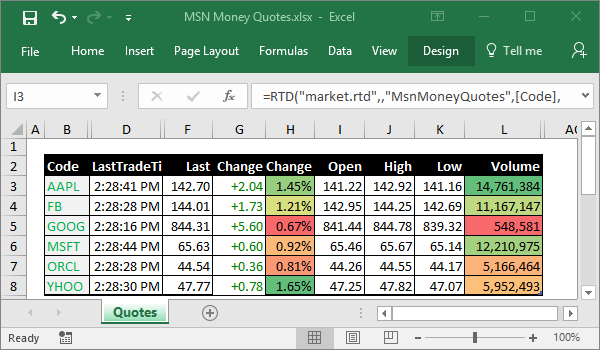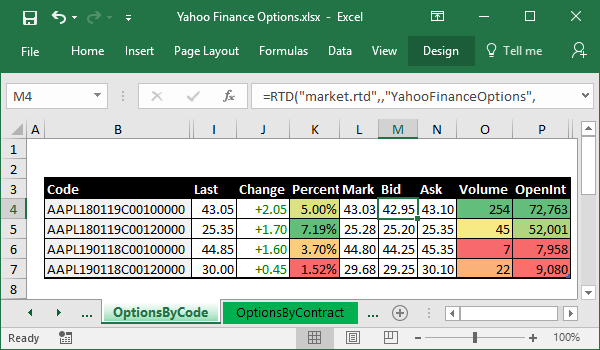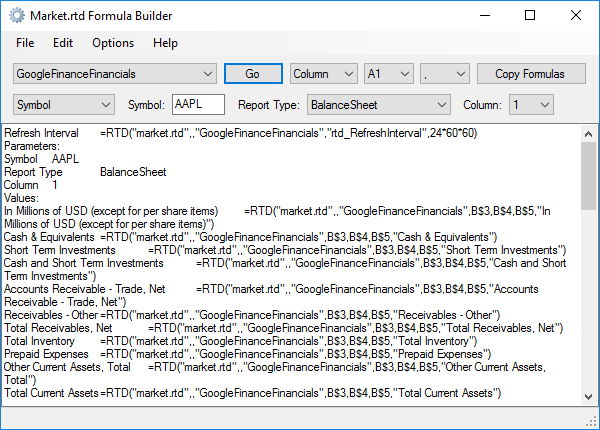Comprehensive Guide to Using Market RTD in Excel
Concept
Market RTD enables you to load quotes, historical prices, key statistics, financials, and option chains from Yahoo Finance and MSN Money into Excel.
For example, you can create reports like these:

or this:

In both cases, you use standard RTD formulas such as:
=RTD("market.rtd",,"MsnMoneyQuotes",,"AAPL","Last")
=RTD("market.rtd",,"YahooFinanceOptions","AAPL180119C00120000","Bid")
The formula structure is as follows:
=RTD("market.rtd",,"<provider>"[,<Parameter1>[,<Parameter2>[,<Parameter3>]]],"<Data Field>")
- market.rtd is the RTD server name.
- <provider> is the name of a data provider, such as MsnMoneyQuotes or YahooFinanceOptions.
Parameters and data fields vary by data provider.
You can generate formulas using the Formula Builder. In the first step, select a provider:

In the subsequent steps, configure your formulas and paste them into your Excel spreadsheets.

Open the Formula Builder by navigating to Start, All Programs, Market RTD, Formula Builder.
For more details, refer to the Formula Builder description.
You can also find formatted reports in the Examples folder of the downloaded package.
Refresh Intervals
You can modify the refresh interval (in seconds or as hh:mm:ss) for any provider using a formula like this (for a 15-minute interval):
=RTD("market.rtd",,"YahooFinanceQuotes","rtd_RefreshInterval",15*60)
Avoid making excessive requests to the website, as this may result in your IP being banned.
Tickers
Use the Yahoo Finance or MSN Money websites to locate tickers.
Examples
Examples are available in the Examples folder of the downloaded package.
Use these examples as templates or for troubleshooting formulas and loading data.
Tick Fields
You can utilize special tick fields by adding the :tick suffix to the data field name.
For example:
=RTD("market.rtd",,"YahooFinanceQuotes","AAPL","Last")
=RTD("market.rtd",,"YahooFinanceQuotes","AAPL","Last:tick")
Tick values indicate:
| Tick Value | Meaning |
|---|---|
| 1 | The value has increased |
| 0 | The value remains unchanged |
| -1 | The value has decreased |
Tick fields can be used for conditional formatting of the underlying fields or as independent columns.
Monitoring
You can use special data fields to monitor data downloads.
For example:
=RTD("market.rtd",,"YahooFinanceQuotes","AAPL","rtd_LastUpdate")
=RTD("market.rtd",,"YahooFinanceQuotes","AAPL","rtd_LastError")
The formulas above display the last data update time and the last error code for the AAPL ticker.
Refer to the complete list of special data cells for more information.
Configuring
You can adjust some of the application settings.
Open the configuration file by navigating to Start Menu, All Programs, Market RTD, Configuration File.